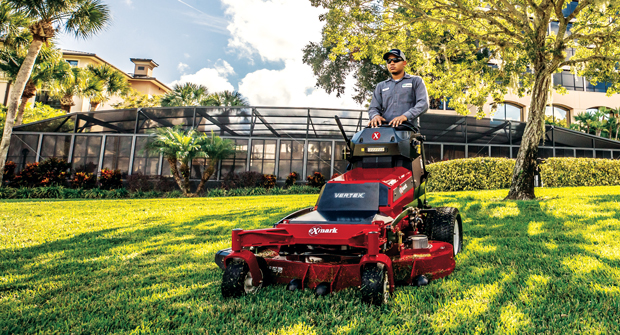Compared to their ride-on counterpart, stand-on mowers haven’t seen the same level of development over the last several years, according to experts. That said, mower manufacturers have been listening to what the contractor wants and taking notes.
“Landscape contractors are looking for more productivity,” Chris Lammie, director of product marketing for Exmark, says. “How can they cut more grass better and faster without breaking down? We’ve focused on adding horsepower, deck width, durability and reliability, making them easier to maintain and repair.”
Lammie and Gavin Dobson, product specialist at Grasshopper, share what landscape contractors can expect from the industry’s newest ride-on mowers and offer a look at what’s next.
Bigger and badder
According to Lammie, mower manufacturers have had several major areas of focus for improvements to stand-on zero-turn mowers. That starts with engine horsepower and cutting deck width, as companies aim to cut grass faster than ever before.
“Five years ago, you’d have a 60-inch stand-on that went 10 miles per hour (mph),” he says. “Now we’ve got a 72-inch that goes 11 mph, so you’re cutting six acres an hour instead of five. That’s a big jump in productivity and we continue to see that in stand-ons across the board.”
Even with the move to larger decks, Lammie believes there will still be a space in the market for mowers with smaller profiles. Exmark, he says, just recently relaunched 32- and 36-inch stand-on mowers due to a growing demand for machines that can fit through gates into backyards.
More improvements
Alongside cutting power and speed, Lammie and Dobson point to several other improvements for stand-on mowers over the last several years, including ease of operation, operator comfort and easier maintenance.
“We work on minimizing the number of grease points so (operators) don’t have to do as much inspection and greasing at the beginning of the day,” Lammie says. “We also aim to get rid or consolidate parts over time so that we can reduce the number of potential failures on the machine.”
Keeping comfortable
A former landscape professional himself, Dobson has years of firsthand experience with stand-on mowers. During his time on mowers, he’s found that operator comfort features have come a long way.
“10 or 15 years ago, most mowers just had a standard seat or platform,” he says. “But now, you’re seeing suspension seats and platforms. It’s all about making sure the operator isn’t fatigued after an eight-hour mowing day.”
Now, at Grasshopper, Dobson says manufacturers — including his employer — are creating mowers with the operator’s comfort in mind. That starts with the frame, where reducing vibration is a major point of emphasis and moves to the mower’s controls where ergonomic handles take the brunt of the vibrations.
Another area where manufacturers are adding comfortability features according to Dobson is the tower, with some mowers allowing users to adjust it based on their height.
Electric on the way
Looking to the future, both Dobson and Lammie believe that the next major step for most zero-turn mowers will be electrification.
“You can’t go to a trade show now without seeing a bunch of battery-powered mowers,” Lammie says. “We are still waiting probably for the volume to catch up because it doesn’t make sense yet for everyone. But that’s been a big change in the industry, I would say in the past three, four years in terms of commercial acceptance.”


